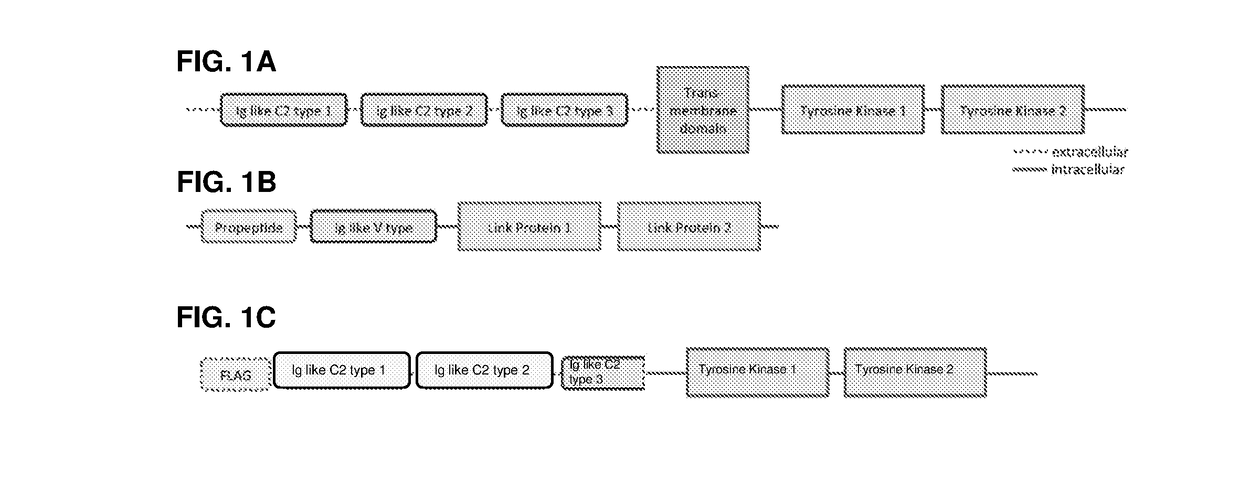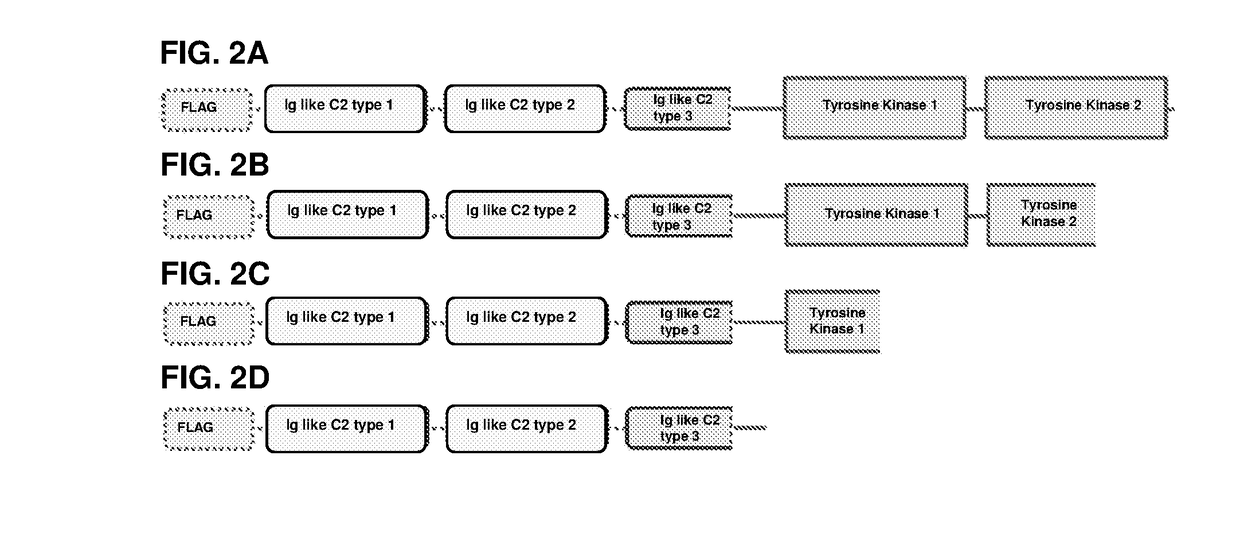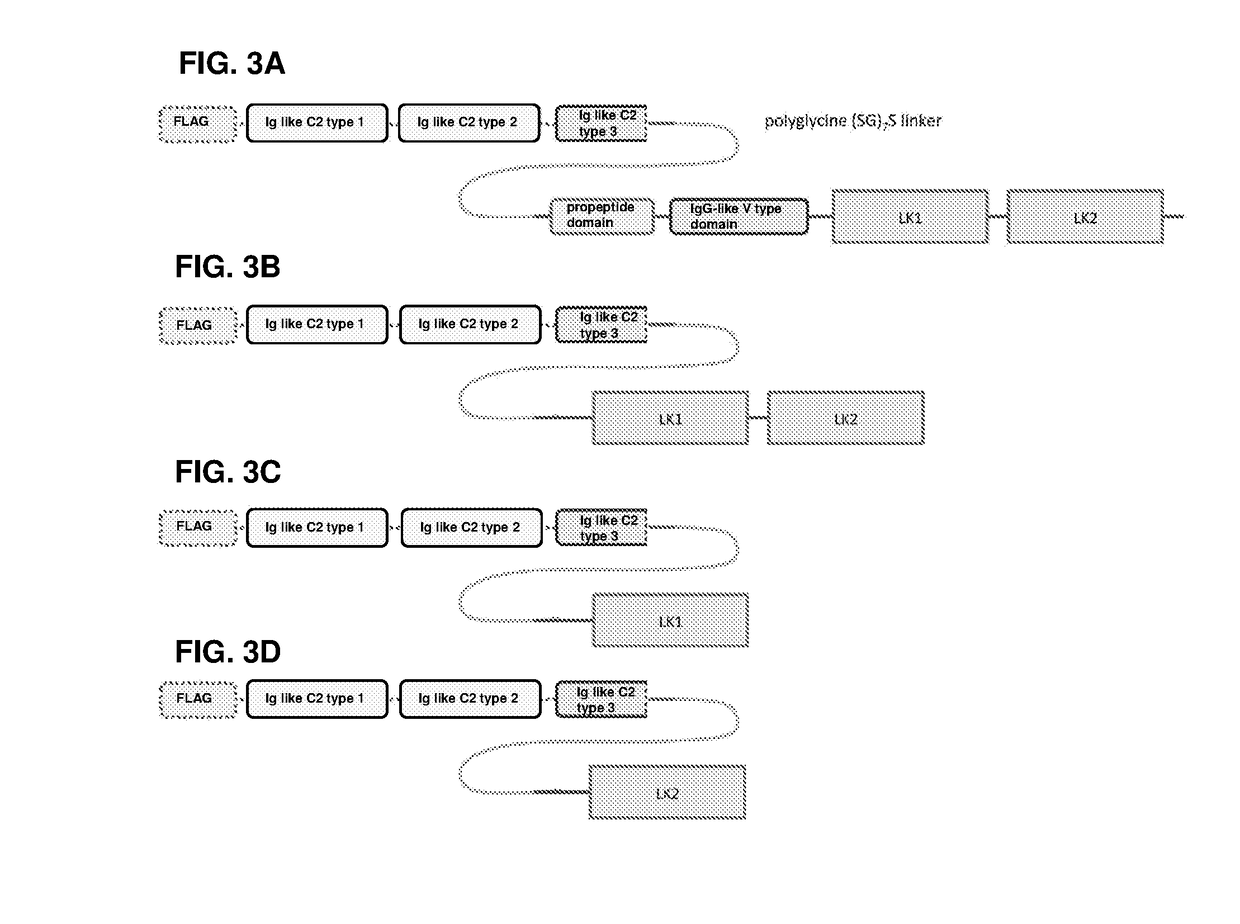Soluble fgfr3 decoys for treating skeletal growth disorders
- Summary
- Abstract
- Description
- Claims
- Application Information
AI Technical Summary
Benefits of technology
Problems solved by technology
Method used
Image
Examples
example 1
Decoy Design and Testing Procedures
Structures and Sequences of the Different Protein Variants.
[0148]A diagram of the different domains of FGFR3, HPLN1 and a soluble FGFR3 (sFGFR3) is shown in FIG. 1 (see PCT / EP2014 / 050800). The FGFR3 deletion variants of the examples are shown in FIG. 2 and the fusion proteins of the examples are shown in FIG. 3.
[0149]SEQ ID NO: 1 provides the amino acid sequence of sFGFR3 of PCT / EP2014 / 050800, SEQ ID NO: 2 the amino acid sequence of the same sFGFR3 but with the full Ig like C2 type domain 3, SEQ ID NO: 3 the amino acid sequence of HPLN1, SEQ ID NO: 4 the amino acid sequence of FLAG-sFGFR3_Del4-LK1-LK2 (see FIG. 3B), SEQ ID NO: 5 the nucleic acid sequence of FLAG-sFGFR3_Del4-LK1-LK2 (see FIG. 3B), and SEQ ID NO: 6 the wild-type human FGFR3.
Cloning and Protein Production System.
[0150]The Del plasmids were obtained by site directed mutagenesis of the sFGFR3-pFLAG-CMV3 plasmid. The cDNA sequence for LK1-LK2 was optimized for Homo Sapiens while encoding...
example 2
In Vitro Testing of the Deletion Variants
[0162]Summary: All four sFGFR3_Del1, sFGFR3_Del2, sFGFR3_Del3 and sFGFR3_Del4 variants bind human FGF2 with similar affinity than the sFGFR3 full-length construct. sFGFR3_Del4 binds FGF9 with the same affinity as FLAG-sFGFR3.
[0163]All four variants were tested in vitro for their ability to bind human FGF2. Similar to the protocol used to validate the mechanism of action of the FLAG-sFGFR3 molecule; different amounts of FLAG-sFGFR3_Del were incubated with constant quantities of FGF2. All variants bind human FGF2 in a receptor-dose-dependent manner with a similar affinity than the initial FLAG-sFGFR3 protein (FIG. 4A). Linear regression analysis showed no statistical differences between the five slopes (P=0.5478). sFGFR3_Del4 was also able to bind human FGF9 in a dose-dependent manner (FIG. 4B).
example 3
In Vitro Testing of the Del4 Deletion Variant
[0164]Summary: Del4 is effective at restoring bone growth in transgenic Fgfr3ach / + mice.
[0165]To evaluate FLAG-sFGFR3_Del4 for its therapeutic efficacy, 3 day-old animals received 2.5 mg / kg of protein twice per week for 3 weeks. Control groups received vehicle. Experiments were performed blinded. A total of 108 animals were included.
[0166]The biological effects of FLAG-sFGFR3_Del4 were evaluated following a 3-week-long injection regimen to 3 day-old neonate mice. All newborn male and female mice from one litter received the treatment twice per week over the course of 3 weeks: 2.5 mg / kg FLAG-sFGFR3_Del4, (n=74) or vehicle for control groups (n=52). The first observation was the significant reduction in mortality with treatment: mortality for vehicle-treated Fgfr3ach / + mice was 63% compared with 40% in the treated group.
[0167]The velocity of growth was evaluated during the three-week treatment by monitoring cranium length and body weight on...
PUM
| Property | Measurement | Unit |
|---|---|---|
| Pharmaceutically acceptable | aaaaa | aaaaa |
Abstract
Description
Claims
Application Information
 Login to View More
Login to View More - R&D
- Intellectual Property
- Life Sciences
- Materials
- Tech Scout
- Unparalleled Data Quality
- Higher Quality Content
- 60% Fewer Hallucinations
Browse by: Latest US Patents, China's latest patents, Technical Efficacy Thesaurus, Application Domain, Technology Topic, Popular Technical Reports.
© 2025 PatSnap. All rights reserved.Legal|Privacy policy|Modern Slavery Act Transparency Statement|Sitemap|About US| Contact US: help@patsnap.com



